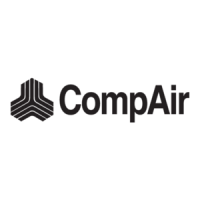70
Whenever the machine/system is
completely powered down for maintenance
and repair procedures, it has to be
secured against unintentional power-on
or the mains supply has to be cut off
with electrical systems.
* Remove the ignition key, and / or
* Put up a warning sign on the main
switch “Attention! Maintenance work.”
Close off the complete maintenance
area, if required.
* Disconnect the starter battery.
Before removing or opening any part
under pressure, separate the equipment
effectively from all sources of pressure and
release the pressure from the complete
system.
For moveable machines support the
towing mechanism and axle with
appropriate means if work is to be carried
out underneath the units (a jack is not
sufficient).
Observe the safety precautions for work
on batteries.
Pay attention to cleanliness. Prevent dirt
from entering by sealing the parts and
exposed openings with a clean cloth,
paper, or tape.
Before the aggregate is approved for
operation after maintenance or an
overhaul, make sure that operating
pressures, temperatures, and time settings
are correct and that the control and
shutdown devices are working properly.
The electric motor, generator, air filter,
electrical components and control
equipment are to be protected against the
penetration of dampness - for example
when cleaning with a steam jet - by
covering or sealing them.
Under no circumstances should the
sound-insulating material be removed or
modified.
Never use solvents with dangerous
properties for cleaning parts.
Maintenance work, tests, and repairs
should be carried out in a well ventilated
room, away from heat, open flames, or
sparks. Appropriate prohibition signs (fire,
open flames, no smoking) must be put up.
Wear suitable eye protection when
inspecting the system. Make sure that the
openings of spray containers, valves,
pipes, or atomizers are never directed at
yourself or at any other person during the
inspection.
The fuel used in these systems is highly
inflammable, toxic and poisonous. Avoid
contact with eyes and skin, and never
inhale vapors. Should you accidentally
swallow fuel, do not induce vomiting, but
seek medical attention.
Should fuel come into contact with the
eyes, or in case of eye irritation by vapors,
flush eyes with plenty of clean water and
seek medical attention.
Every time a message is displayed or
there is a suspicion that an internal part
of the machine has overheated, the
machine must be shut down. Never open
the inspection cover, however, before the
machine has cooled down sufficiently to
rule out the possibility of the oil vapors
igniting spontaneously when mixed with air.
In order to avoid an increase in operating
temperature, inspect and clean the heat
transfer surfaces (cooling ribs etc.)
regularly. Draw up a schedule for the most
suitable cleaning intervals for each
machine.
Avoid damaging the safety valves and
other pressure-reducing devices. In
particular, make sure that they are not
blocked through paint, oil carbon, or
dust accumulation, which could impair
the effect of these devices.
The insulation or protective shielding of
parts whose temperature may exceed
80 °C and which may accidentally be
touched by personnel may not be removed
before these parts have cooled down to
room temperature.
Check the accuracy of the pressure
and temperature displays regularly. If the
permissible tolerance limits have been
exceeded, then they must be replaced.
Never carry out welding work or any other
work that produces heat in the vicinity of
fuel or oil systems. Systems, which could
contain fuel or oil, have to be completely
drained and cleaned, e.g. by means of a
steam jet, before proceeding with the work
to be carried out.
Never carry out any welding work on any
pressure tank or components under
pressure, or modify them in any way.
If work causing heat, flames, or sparks
has to be carried out on a machine, the
surrounding components must be protected
with nonflammable material.
Before dismantling or overhauling a
compressor, engine, or any other machine,
make sure that no movable part with a
weight of more than 15 kg can move or roll
away.
Machines whose main movement is back
and forth must be moved at least once,
rotating machines several times, in order to
make sure that there is no mechanical
malfunction in the machine or in the driving
part.
Only experienced persons may be
charged with slinging loads and instructing
crane drivers. These instructors must
remain within sight of the operator or be in
touch with him via walkie-talkie or similar
device.
During assembly work above body
height, use appropriate or otherwise safety-
relevant climbing aids and working
platforms. Do not use machine parts as
climbing aids! Wear safety belts when
carrying out maintenance work at greater
heights.
Keep all steps, handles, railings,
platforms, scaffolds, and ladders free of
dirt, snow, and ice.
Before beginning maintenance and
repair, clean the machine, particularly
couplings and bolted connections, of oil,
fuel, and special care products. Do not use
aggressive detergents. Use lintfree cloths
for cleaning.
After cleaning, remove all covers and
seals.
After cleaning, check all fuel, engine oil,
and hydraulic fluid lines for leaks, loose
connections, chafing and damage. Correct
any faults immediately.
Always tighten bolted connections
loosened during maintenance and repair
work.
If it is necessary to dismantle safety
devices during machine set-up,
maintenance, and repair work, the safety
devices must be reassembled and checked
immediately after completing the
maintenance and repair work.
Ensure safe, environment-friendly
disposal of process materials as well as
replaced parts. Components containing oil,
for example fine separators, and oils must
be disposed of. Oil must not enter the soil!
Safety precautions for work with
batteries
The fluid contained in batteries is diluted
sulfuric acid which can cause blindness if
brought into contact with the eyes, or
serious burns if brought into contact with
the skin. For this reason it is essential to
work with the greatest of care when
servicing batteries, e.g. when checking
battery charge, and to take all necessary
safety precautions.
3. Security Regulations

